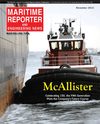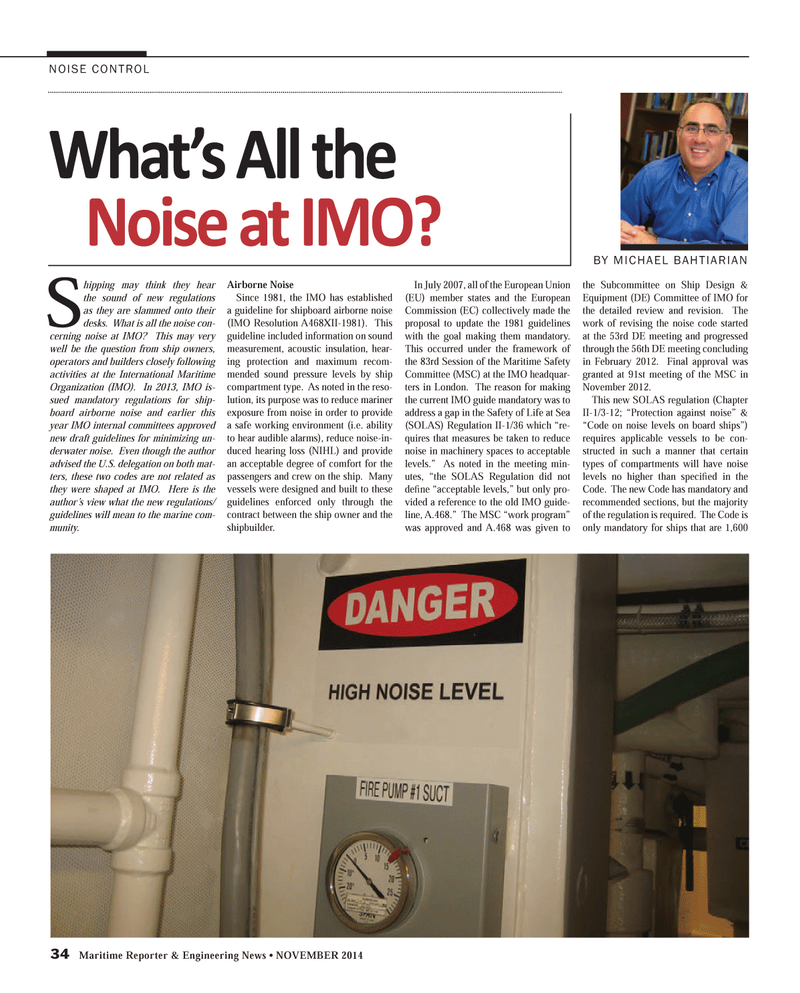
Page 34: of Maritime Reporter Magazine (November 2014)
Workboat Edition
Read this page in Pdf, Flash or Html5 edition of November 2014 Maritime Reporter Magazine
34 Maritime Reporter & Engineering News • NOVEMBER 2014
NOISE CONTROL
S hipping may think they hear the sound of new regulations as they are slammed onto their desks. What is all the noise con- cerning noise at IMO? This may very well be the question from ship owners, operators and builders closely following activities at the International Maritime
Organization (IMO). In 2013, IMO is- sued mandatory regulations for ship- board airborne noise and earlier this year IMO internal committees approved new draft guidelines for minimizing un- derwater noise. Even though the author advised the U.S. delegation on both mat- ters, these two codes are not related as they were shaped at IMO. Here is the author’s view what the new regulations/ guidelines will mean to the marine com- munity.
Airborne Noise
Since 1981, the IMO has established a guideline for shipboard airborne noise (IMO Resolution A468XII-1981). This guideline included information on sound measurement, acoustic insulation, hear- ing protection and maximum recom- mended sound pressure levels by ship compartment type. As noted in the reso- lution, its purpose was to reduce mariner exposure from noise in order to provide a safe working environment (i.e. ability to hear audible alarms), reduce noise-in- duced hearing loss (NIHL) and provide an acceptable degree of comfort for the passengers and crew on the ship. Many vessels were designed and built to these guidelines enforced only through the contract between the ship owner and the shipbuilder.
In July 2007, all of the European Union (EU) member states and the European
Commission (EC) collectively made the proposal to update the 1981 guidelines with the goal making them mandatory.
This occurred under the framework of the 83rd Session of the Maritime Safety
Committee (MSC) at the IMO headquar- ters in London. The reason for making the current IMO guide mandatory was to address a gap in the Safety of Life at Sea (SOLAS) Regulation II-1/36 which “re- quires that measures be taken to reduce noise in machinery spaces to acceptable levels.” As noted in the meeting min- utes, “the SOLAS Regulation did not de? ne “acceptable levels,” but only pro- vided a reference to the old IMO guide- line, A.468.” The MSC “work program” was approved and A.468 was given to the Subcommittee on Ship Design &
Equipment (DE) Committee of IMO for the detailed review and revision. The work of revising the noise code started at the 53rd DE meeting and progressed through the 56th DE meeting concluding in February 2012. Final approval was granted at 91st meeting of the MSC in
November 2012.
This new SOLAS regulation (Chapter
II-1/3-12; “Protection against noise” & “Code on noise levels on board ships”) requires applicable vessels to be con- structed in such a manner that certain types of compartments will have noise levels no higher than speci? ed in the
Code. The new Code has mandatory and recommended sections, but the majority of the regulation is required. The Code is only mandatory for ships that are 1,600
What’s All the Noise at IMO?
BY MICHAEL BAHTIARIAN
MR #11 (34-41).indd 34 10/23/2014 11:45:06 AM

 33
33

 35
35
